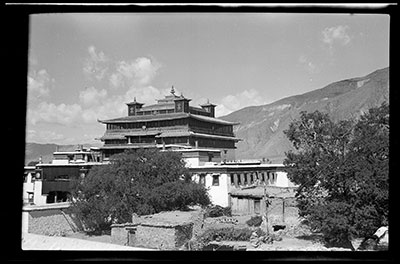
2001.59.13.32.1 (Film negative)


2001.59.13.32.1 (Film negative)

Hugh E. Richardson
Hugh Richardson
1949
Tsangpo Valley Region > Samye
2001.59.13.32.1
85 x 60 mm
Negative film nitrate
Donated August 2001
The executors of the estate of Hugh E. Richardson
Richardson's 1949 tour of the Yarlung and Chyongye valleys
Manual Catalogues - Notes on negative album - 'NYEMO. SAMYE. YARLUNG. RGYAL.' is written on the cover of this blue negative album in white in Richardson's hand. [KC 24/3/2006]
Manual Catalogues - Notes on Blue negative album index - No. 32. 'do.' [SAMYE]'.
Manual Catalogues - Richardson's handlist: 'Blue Album. [Nos.] 29-35. 'do' [Bsam yas, founded c 779. (now destroyed)].
Other Information - Background: Richardson visited Samye in 1949 and describes the site in High Peaks, Pure Earth , London, Serindia Publications, 1998, p. 315-6. "About twenty-six miles downstream [of Gong-dkar Rdzong] on the north bank [of the Tsangpo] is Bsam-yas (1949), "Beyond Imagining", the oldest, most famous, most beautiful and most numinous of Tibetan monasteries. Founded in 779 by Padmasambhava and the Indian pundit Santaraksita under the patronage of the King Khri Srong-lde-brtsan, it was conceived as the realization of an ideal universe in the form of a mandala. The spacious precinct is surrounded by a high wall representing the ocean, with a differently shaped temple at each of the cardinal points for continents and smaller island temples on either side. Some way inside the wall are four large mchod-rten , each in the colour appropriate to its geogaphical position - red at the south-west, black at the north-west, blue at the north-east, and white at the south-east. At the centre, enclosed in a high wall piercwed by doors on the east, south, north and west, stands, foursquare, the great dbu-rtse or gtsug-lag-khang , the symbol of Mount Me-ru, the centre of the universe. It is ... four storeys tall, having been vandalised and half destroyed by the Chinese in 1966. The lower two storeys are of massive white dressed stone, the upper two of fine timber, the topmost being of smaller dimensions than the other three, giving a rather pyramidal appearance. ..."
Technical Information - This photograph was taken using a Zeiss Super Ikonta camera which could take images of 6x9 cm. This was the largest negative exposure size that Richardson could take advantage of with the two cameras that he owned (the other being a Reflex Korelle, which 6x6 cm images). This size produced contact prints of sufficient size that they could be used as prints without further enlargement. However, it was only possible to take 8 images per role with this size of image. By the late 1940s, generally Richardson seems to have used this size image less and less and the choice on this tour probably reflects the significance of the site and the fact that Richardson wanted to take readable photographs of the inscription pillar there, as previously he had relied upon copies made available to him by Sir Charles Bell [ A Corpus of Early Tibetan Inscriptions , Royal Asiatic Society, James G. Forlong Series, No. XXIX, Hertford: Stephen Austin & Sons Ltd, 1985, p.26] [MS 17/12/2005]
Other Information - Dates: Richardson states that he photographed the Samye inscription pillar in 1949 [ A Corpus of Early Tibetan Inscriptions , Royal Asiatic Society, James G. Forlong Series, No. XXIX, Hertford: Stephen Austin & Sons Ltd, 1985, p.26] [MS 17/12/2005]
For Citation use:
The Tibet Album.
"The Utse temple at Samye monastery"
05 Dec. 2006. The Pitt Rivers Museum.
<http://tibet.prm.ox.ac.uk/photo_2001.59.13.32.1.html>.
For more information about photographic usage or to order prints, please visit the The Pitt Rivers Museum.
© The Pitt Rivers Museum